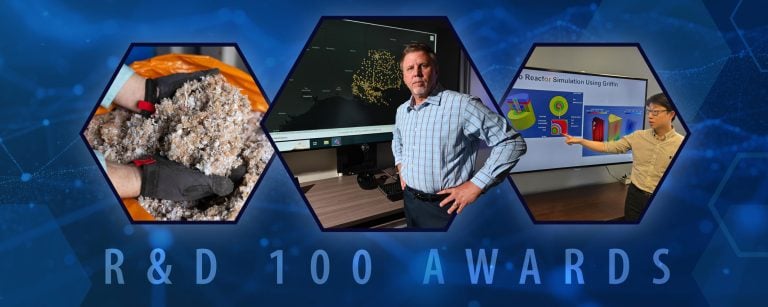Manufacturing and processing materials on an industrial scale consume a lot of energy and natural resources. That’s why public and private entities are teaming up to develop new technologies that use less of both.
Idaho National Laboratory is involved in three recycling research projects being funded by the REMADE Institute (Reducing Embodied Energy and Decreasing Emissions). The first round of research funding for the effort was announced last month.
Launched in early 2017, the REMADE Institute is one of 14 National Manufacturing Institutes that make up the Manufacturing USA Federal initiative. Led out of Rochester, New York, REMADE’s purpose is to spur development of advanced manufacturing technologies that use less energy and generate less waste material and carbon emissions.
Funding for 17 projects announced in July amounts to $10 million, with $4 million coming from the U.S. Department of Energy and the rest from private industry cost-share contributions. Including INL, REMADE has partnerships with 30 organizations that will be participating in the projects.
REMADE is organized into five technology nodes: Systems Analysis and Integration, Design for Reuse/Disassembly, Manufacturing Material Optimization, Remanufacturing and Reuse, and Recycling and Recovery. INL has been designated the lead lab in support of the Recycling and Recovery node.
“It represents an opportunity for the lab to expand its footprint in the systems analysis and materials recycling area,” said Eric Peterson, who directs INL’s REMADE involvement.
The three projects in which INL is participating involve recycling plastics and waste from consumer electronics such as cellphones and laptops.
Film and flexible packaging: Flexible packaging and plastic wraps – everything from the shrink wrap on a case of bottled water to air pillows in a box from Amazon – have become a dominant form of packaging in the United States. Excluding industrial uses, approximately 12 billion pounds of these materials are introduced to the U.S. market each year. Yet in 2015 only about 209 million pounds — less than 1 percent of plastic films, bags and wraps — were collected for postconsumer recycling, mostly through drop-off; the remainder goes to landfills or is lost to the environment as litter.
Most curbside systems are not equipped to handle film. Systems for separation and identification are not in place, and film can jam municipal recycling facility (MRF) equipment that is not designed to handle it. Flexible films also can contaminate paper product bales, presenting a serious and growing problem for paper manufacturers. Once these films are sorted into recovered flexible (rFlex) bales, further technical and economic barriers exist, including the need for washing and cleaning to prepare it for reclamation.
The REMADE project, called Determining Material, Environmental, and Economic Efficiency of Sorting and Recycling Mixed Flexible Packaging and Plastic Wrap, seeks to examine barriers along every stage of the recovery process. The project is a joint effort between the American Chemistry Council (ACC), INL and Resource Recycling Systems (RRS). ACC and RRS are already working on a project called Materials Recovery Facility for the Future (MRFF), which involves optimizing recyclers’ ability to sort flexible packaging.
Evaluating e-scrap systems: The project, Evaluation of logistics Systems for Collection, Reprocessing, and Production of Secondary Feedstocks from e-Waste, will examine inefficiencies within the logistics of the current electronics recycling system. It is being conducted by INL and SunnKing, an electronics recycling company based in Brockport, New York.
Electronics recycling in the U.S. has grown over the last two decades to include hundreds of organizations and tens of thousands of workers, yet most e-waste fails to enter the recycling stream. A survey of recyclers found that while residential users are the major electronics consumers, 75 percent of total material entering the recycling stream comes from industrial sources. The inability to capture the most plentiful segment of the potential recycling stream suggests inefficiency in the current logistics system.
There are two chief reasons why residential e-wastes are not being recycled. First is the ineffective placement of collection facilities, and the second is the lack of economic incentive. This results in low availability of raw feedstocks, pushing costs higher due to competition between recyclers. Further inefficiency occurs from stakeholders’ lack of understanding of the entire supply system. Rather than improving and expanding their collection systems, many supply chain stakeholders have chosen to focus on reducing costs or increasing productivity of their individual systems.
Circular economy considerations: This plastics recycling-related project, titled Systems Analysis for PET and Olefin Polymers in a Global Circular Economy, seeks to incorporate circular economy concepts into other analysis tools. The work will be carried out by the ACC, INL and Michigan Technological University.
Polyethylene Terephthalate, commonly referred to as PET or PETE, is best known as the clear plastic used for water and soda bottle containers. They make up a significant fraction of waste that ends up in landfills and in the oceans. Representing 15 leading plastics manufacturers, AAC’s Plastics Division earlier this year announced a goal of 100 percent plastics packaging being recyclable or recoverable by 2030 and 100 percent of plastics packaging reused, recycled or recovered by 2040.
Looking beyond the current “take, make and dispose” extractive industrial model, the circular economy has been proposed as restorative and regenerative by design. A circular economy seeks to rebuild capital, whether it is financial, manufactured, human, social or natural. This ensures enhanced flows of goods and services. No work has been attempted to integrate circular economy concepts for plastics.
REMADE’s Goals
The REMADE Institute partners intend to develop technology capable of:
- Reducing primary feedstock consumption in manufacturing by 30 percent.
- Achieving 25 percent reduction in embodied energy of targeted materials.
- Achieving cost parity for secondary materials.
- Improving energy efficiency of secondary material processing by 30 percent.





